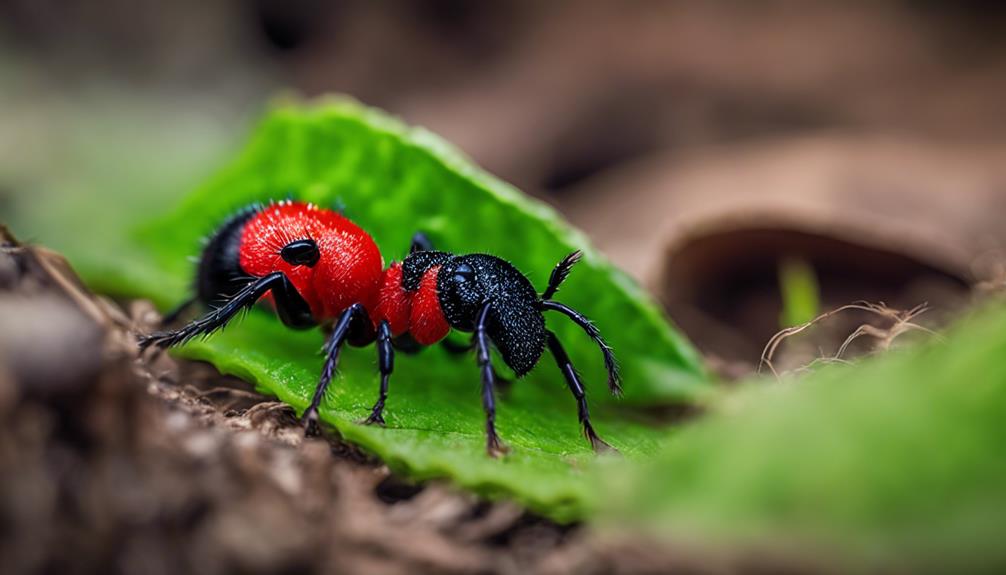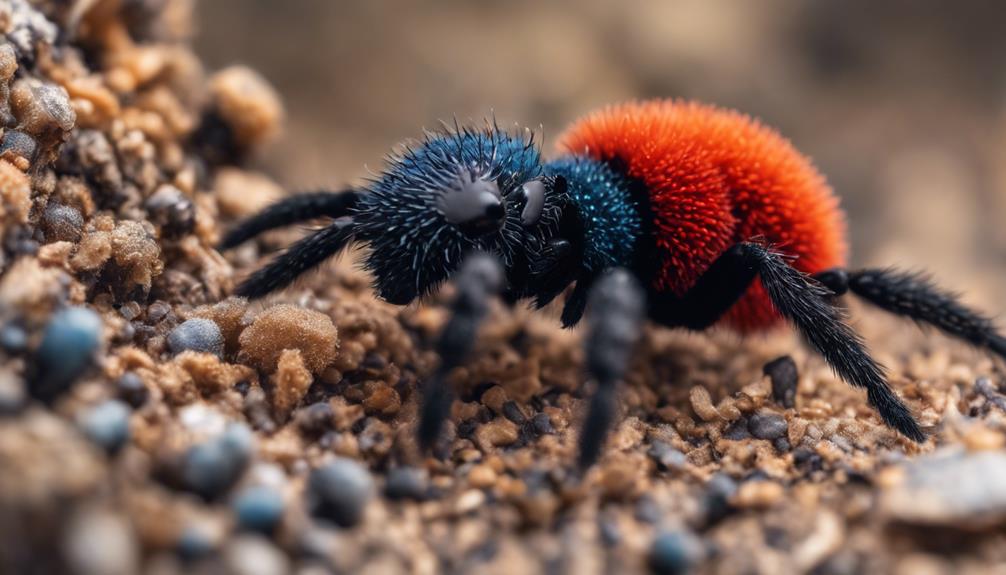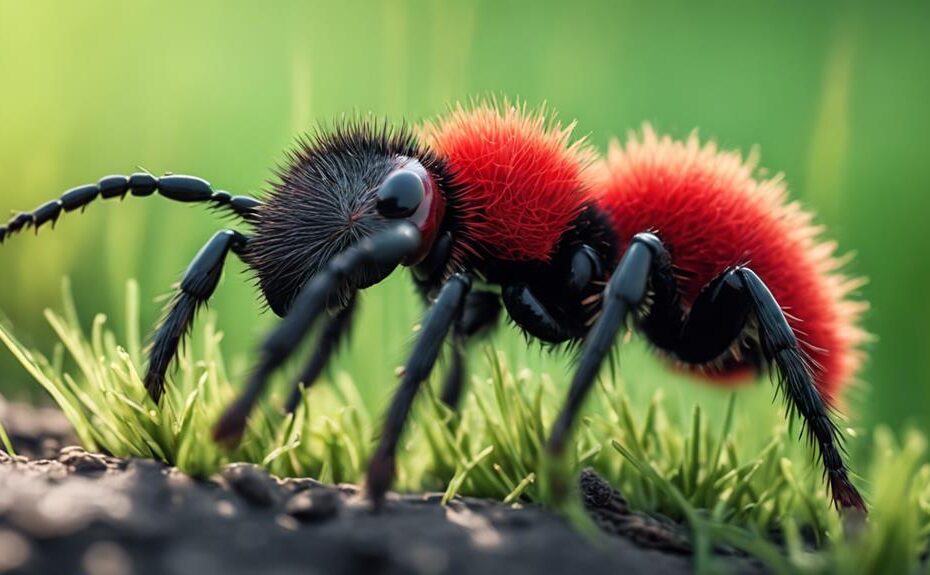Velvet ants, often mistaken for ants due to their name, are in fact a type of wasp. These insects possess a fascinating trait where female velvet ants are equipped with a potent sting that can cause considerable pain.
Their vivid coloration serves as a warning to predators, hinting at their defensive capabilities. Despite their name, velvet ants are solitary creatures, leading intriguing lives away from typical ant colony dynamics.
Lastly, their parasitic larvae add a layer of complexity to their already enigmatic nature.
Velvet Ants Are Actually Wasps
Velvet ants, despite their common name which suggests they are ants, are actually a species of wingless wasps belonging to the family Mutillidae. These unique insects are predominantly found in warmer climates worldwide. Velvet ants are known for their striking and unmistakable appearance, with females being particularly noteworthy for their dense, velvety hair that can range in color from bright red and orange to black or white. This distinctive appearance serves as a warning to potential predators due to their potent stingers.
Female velvet ants are solitary creatures that spend their adult lives searching for the larvae of other insects to parasitize. They lay their eggs on the larvae, and once hatched, the velvet ant larvae feed on the host larvae until they pupate and emerge as adults. This parasitic behavior is crucial for the survival and reproduction of female velvet ants, making them fascinating subjects for scientific study.
Female Velvet Ants Pack a Sting
Despite their small size, female velvet ants possess a potent sting that serves as a powerful defense mechanism against potential threats. Velvet ants, also known as cow killers, are wingless wasps with females being equipped with a stinger at the tip of their abdomen. This stinging defense is primarily used when they feel threatened or are under attack. The sting of a female velvet ant is known to be extremely painful, causing intense discomfort to predators or individuals who accidentally step on them.
To understand the impact of the female velvet ant's sting, let's compare it to other insect stings:
| Insect | Severity of Sting |
|---|---|
| Female Velvet Ant | Extreme Pain |
| Honey Bee | Moderate Pain |
| Fire Ant | Burning Sensation |
| Paper Wasp | Sharp Pain |
| Bullet Ant | Intense Pain |
In addition to defense, the female velvet ant's sting also plays a crucial role in their mating rituals, where it can be used to fend off competing males or predators during courtship displays.
Velvet Ants Have Striking Coloration

The coloration of velvet ants is characterized by vibrant hues and striking patterns that serve as a warning to potential predators. Velvet ants employ mimicry strategies through their coloration patterns to deter predators and communicate their defenses effectively. Here are some key points about the striking coloration of velvet ants:
- Bright Colors: Velvet ants often display bright colors such as red, orange, and black, which are easily noticeable in their natural habitats.
- Contrasting Patterns: Their bodies feature contrasting patterns like stripes, spots, or bands, enhancing their visual impact.
- Warning Signal: These colors and patterns act as a warning signal to predators, indicating that velvet ants are not suitable prey.
- Aposematic Coloration: The vivid coloration is a form of aposematism, warning predators of their potential danger.
- Protective Adaptation: This coloration serves as a protective adaptation, deterring predators through visual cues rather than physical confrontation.
Velvet ants' striking coloration is a fascinating aspect of their biology, aiding in their survival within diverse ecosystems.
They Are Solitary Insects
Solitude is a defining characteristic of velvet ants, as they typically lead solitary lifestyles within their respective habitats. Velvet ants are known to be solitary insects, with females living and foraging alone. This solitary lifestyle is particularly notable in their reproductive behavior. Female velvet ants are responsible for locating the nests of other solitary bees or wasps, where they lay their eggs near the host's larvae. Once the velvet ant larvae hatch, they parasitize the larvae of the host insect, feeding on their tissues until they develop into adult velvet ants.
This solitary nature is also reflected in their general behavior, as velvet ants do not form colonies like other social insects such as bees or ants. Each female velvet ant is responsible for finding food, laying eggs, and ensuring the survival of her offspring independently. This solitary lifestyle allows velvet ants to adapt to various environments and develop unique survival strategies tailored to their specific habitats.
Velvet Ant Larvae Parasitize Other Insects

Female velvet ants display a unique reproductive strategy by parasitizing the larvae of other insects, utilizing them as hosts for their own offspring to develop. This parasitic behavior ensures the survival and growth of velvet ant larvae, as they rely on the resources provided by the unsuspecting insect hosts.
Here are some intriguing facts about velvet ants' parasitic behavior and their relationship with insect hosts:
- Velvet ant larvae feed on the body fluids of the host insect, gradually consuming its tissues.
- Female velvet ants are selective about the type of insect hosts they parasitize, often targeting specific species.
- The parasitic relationship between velvet ants and their hosts can have significant impacts on the population dynamics of the host insect.
- Velvet ant larvae undergo metamorphosis within the body of the host insect, eventually emerging as adult velvet ants.
- The parasitic behavior of velvet ants highlights the complex and fascinating interactions that exist within the insect world, showcasing their remarkable adaptation strategies for survival.
Frequently Asked Questions
Do Velvet Ants Have Any Predators in the Wild?
In the wild, velvet ants face various predators that play a crucial role in predator-prey interactions. These predators include birds, spiders, and other insects.
To survive, velvet ants have developed effective defense mechanisms such as their aposematic coloration, tough exoskeletons, and potent stingers. These adaptations serve as survival strategies against potential threats, allowing velvet ants to deter or defend themselves from predators in their natural habitat.
How Long Do Velvet Ants Typically Live in the Wild?
The average lifespan of velvet ants in the wild can vary depending on the species, environmental factors, and predator pressures. These striking insects typically live for about one year, with some species reaching up to two years.
Mating habits play a crucial role in their life cycle, as female velvet ants are wingless and spend most of their lives searching for suitable hosts to lay their eggs. This behavior contributes to their survival and reproductive success in the wild.
Are Velvet Ants Considered Beneficial or Harmful to Ecosystems?
Velvet ants play a complex role in ecosystems. While they are parasitoids of other insects, they can help control pest populations.
Their ecological impact varies depending on the region and specific species, making conservation efforts challenging.
Velvet ants have economic implications due to their potential for pest control in some agricultural settings.
Balancing their benefits and potential harm requires a nuanced approach to understanding their role in ecosystems.
Can Velvet Ants Be Found in Urban Environments or Do They Prefer Rural Areas?
Velvet ants are predominantly found in rural areas, favoring dry, sandy habitats. While they may occasionally venture into urban environments, they are more commonly associated with rural landscapes.
The distribution of velvet ants is influenced by factors such as availability of suitable hosts and nesting sites. Due to their preference for specific habitats, encountering velvet ants in urban settings may be less common compared to rural areas where their preferred conditions are more abundant.
Are There Any Known Medicinal or Cultural Uses for Velvet Ants in Certain Societies?
Velvet ants have been traditionally used in some societies for their purported medicinal properties. In certain cultures, velvet ants are believed to possess healing properties and are used in remedies for various ailments.
Additionally, these insects hold cultural significance in certain communities where they are revered for their perceived mystical qualities or as symbols of strength and resilience. The historical use of velvet ants in medicinal and cultural practices showcases their diverse roles in different societies.
Conclusion
In conclusion, velvet ants are fascinating insects that are actually wasps, known for their striking coloration and solitary nature.
Female velvet ants possess a powerful sting, while their larvae parasitize other insects.
Their unique characteristics make them a truly intriguing species in the insect world, showcasing the complexity and diversity of the natural world.
Their presence in various ecosystems highlights the interconnectedness of all living organisms, underscoring the importance of biodiversity in maintaining ecological balance.

